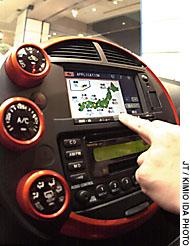Automakers now turning to 'telematics'
 A demonstrator touches the display panel of G-Book, Toyota Motor Corp.'s new "telematics" service. |
The future of driving: Information and entertainment a finger's touch away
Originaly Published In Japan Times By SETSUKO KAMIYA Staff writer
Automakers around the world are increasingly turning to information technology to improve the driving experience for commuters facing longer periods of time in their vehicles.
A demonstrator touches the display panel of G-Book, Toyota Motor Corp.'s new "telematics" service.
With just a touch on a display panel, the new technology, called "telematics," allows drivers to access information on location and direction of travel, emergency assistance and even nearby entertainment facilities.
While these services are generally restricted to luxury models, automakers are pressing the accelerator to further utilize the latest technology.
"In every major market, people are spending more and more time in their vehicles, because commuting and congestion are taking more time out of their lives," said Mark Hogan, group vice president of General Motors Corp. and president of e-GM.
"The goal of telematics, among other things, is to provide a much more functional atmosphere in the vehicle for a lot of people to do things that they would normally do in their homes or in offices. Now we have the technological capability to do that."
While basic services are already available in leading markets, the focus appears to be slightly different between Japanese automakers and their American and European competitors.
Yasuo Tsuchiya, director of Mitsubishi Research Institute Inc., pointed out that Western automakers prioritize emergency support services, while Japanese carmakers stress route and entertainment information based on car navigation systems.
The 1.5 million people in the United States and Canada who subscribe to GM's OnStar service receive safety, security and other roadside convenience features at the push of a button. Drivers can also communicate with operators verbally through voice recognition technology.
German-American automaker DaimlerChrysler AG's Mercedes Benz division has a service called Teleaid, which provides a similar hands-free service for emergency calls. Sensors in the vehicle automatically inform a service center of accidents or breakdowns. Both systems use the global positioning system to pinpoint the vehicle's position.
In Japan, Toyota Motor Corp. introduced a service called Monet in 1997. With an enrollment fee of 2,500 yen and a monthly charge of 600 yen, Monet subscribers can access information about traffic conditions, maps, weather and even nearby restaurants.
Honda Motor Co. and Mazda Motor Corp. operate similar services for free.
Nissan Motor Co. provides Compasslink to subscribers with certain top-end models, charging 3,500 yen initially and 2,500 yen a month thereafter. Users can contact operators by the push of a button.
"It can be difficult to be found if you are involved in an accident in the middle of a vast land," said Tsuchiya, pointing out the difference between Japan and other markets. "People can deal with (accidents) much easier in Japan."
Telematics technology continues to advance in Japan, with many automakers planning advanced services as early as next year.
In mid-2002, Toyota plans to release its new telematics service called G-Book. Its functions will be upgraded from Monet to provide more real-time information and services via the Internet. Subscribers can download games or karaoke songs, and memory cards will allow downloaded material to be shared with other terminals, including personal computers, according to Toyota.
Last month, GM and Toyota began an eight-month joint feasibility study on telematics in the Japanese market by using Toyota's G-Book business infrastructure and services.
Meanwhile, Honda announced in mid-October that it has jointly developed with Nippon Telegraph and Telephone Corp. a new telematics system that connects vehicles with an information service center through voice recognition technology. The service will be launched next year, the firm said.
With telematics becoming a key feature amid faster data transmission speeds brought about by next-generation digital cellular phones, experts say the telematics market will continue to grow.
Mitsubishi Research Institute estimates the domestic telematics market will reach 945 billion yen in 2010, up from an estimated 460 billion yen in 2001.
But some observers believe it will take time before telematics really take off, as automakers remain uncertain about which features will attract customers.
Some automakers admit to sluggish subscriber growth and even withhold information on numbers.
"The automakers are still striving to figure out what sort of features can really bring profit to their business," said Akinobu Okuda, a senior staff researcher at Mitsubishi Research Institute.
Okuda said current demand is for services such as maps, road conditions and weather information, but new services may be added as people's needs change in the future.
With vehicle theft an increasing problem and safety a growing concern, Okuda pointed to accident prevention systems, automatic monitoring of car conditions and security features as likely growth areas.
"People will pay money for safety services if they think it's worth it," he said.
The Japan Times: Nov. 20, 2001


